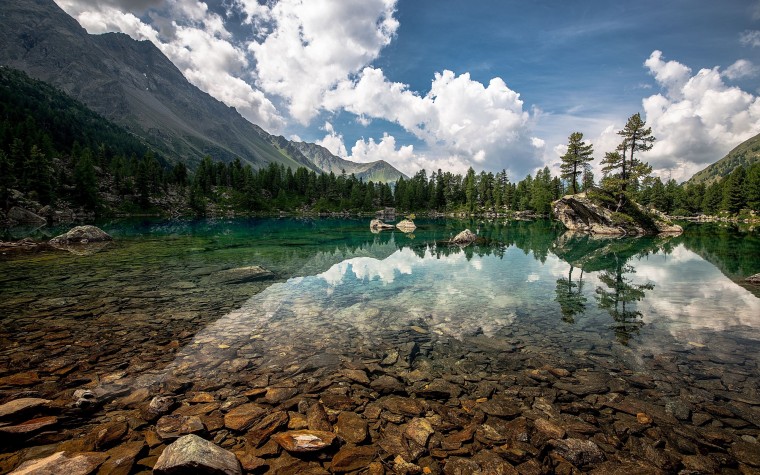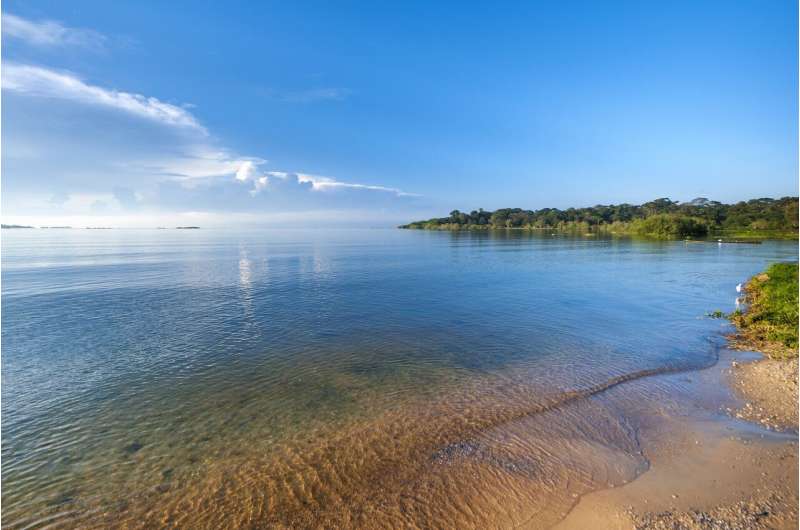The world’s top 10 largest freshwater lakes are some of the most stunning natural wonders on our planet. These expansive bodies hold millions of gallons of freshwater and are home to diverse aquatic life.
The world’s top 10 largest freshwater lakes include Lake Superior, Lake Victoria, Lake Huron, Lake Michigan, Lake Tanganyika, Lake Baikal, Great Bear Lake, Lake Malawi, Great Slave Lake, and Lake Erie. These freshwater lakes are located in different parts of the world and offer visitors breathtaking views and recreational activities such as boating, fishing, and swimming.
List of Top 10 largest freshwater lakes in the World
▪ Here is the list of the Top 10 largest freshwater lakes in the World
| Sl.No | Lakes | Continent | Country |
|---|---|---|---|
| 1 | Lake Superior | North America | United States |
| 2 | Lake Victoria | Africa | Tanzania, Uganda, Kenya |
| 3 | Lake Huron | North America | United States, Canada |
| 4 | Lake Michigan | North America | United States |
| 5 | Lake Baikal | Asia | Russia |
| 6 | Great Bear Lake | North America | Canada |
| 7 | Lake Tanganyika | Africa | Burundi, Tanzania, Zambia, Democratic Republic of the Congo |
| 8 | Lake Malawi | Africa | Malawi, Mozambique, Tanzania |
| 9 | Lake Nicaragua | Central America | Nicaragua |
| 10 | Lake Erie | North America | United States, Canada |
Key points about the World’s 10 largest freshwater lakes
Lake Superior (North America)
- The name “Superior” comes from the French word “supérieur,” meaning “above/upper” or “higher/superior” in English, which refers to the lake’s northern location and elevation compared to the other Great Lakes.
- Lake Superior is the largest freshwater lake in the world by area.
- The lake covers an area of 82,100 square kilometres (31,700 square miles)
- It is the deepest and coldest of the Great Lakes, with a maximum depth of 1,332 feet (406 m).
- Lake Superior is located on the border between the United States and Canada.
- Most of the lake is located in the US state of Minnesota and the Canadian province of Ontario.

- More than 200 rivers and streams feed the lake.
- The lake drains into the St. Marys River, which flows into Lake Huron.
- The lake is known for its cold, clear water, harsh coastline, rich fishing, and shipping history.
- It is home to various fish including lake trout, whitefish, and herring.
- The lake is also known for its shipwrecks, with over 350 recorded shipwrecks in its history.
Lake Victoria (Africa)
- Lake Victoria is one of the African Great Lakes.
- With a surface area of approximately 59,947 km2 (23,146 sq mi), it is Africa’s largest lake by area.
- It is also the world’s largest tropical lake and second-largest freshwater lake by surface area after Lake Superior in North America.
- Regarding volume, Lake Victoria is the world’s ninth-largest continental lake, containing about 2,424 km3 (1.965×109 acre⋅ft) of water.

- The lake occupies a shallow depression in Africa and has an average depth of 40 m (130 ft) and a maximum depth of 80–84 m (262–276 ft).
- The lake’s catchment area covers 169,858 km2 (65,583 sq mi).
▪ It has a shoreline of 7,142 km (4,438 mi) with islands constituting 3.7% of this length.
▪ The lake’s area is divided among three countries: Kenya occupies 6% (4,100 km2 (1,600 sq mi)), Uganda 45% (31,000 km2 (12,000 sq mi)), and Tanzania 49% (33,700 km2 (13,000 sq mi)).
▪ The explorer John Hanning Speke renamed the lake after Queen Victoria, the first Briton to document it in 1858 while on an expedition with Richard Francis Burton.
▪ Lake Victoria is home to many species of fish which live nowhere else, especially cichlids.
▪ Invasive fish like the Nile perch have driven many endemic species to extinction.
Lake Huron (North America)
▪ Lake Huron is one of the five Great Lakes of North America.
▪ It is hydrologically linked to Lake Michigan and shares the same surface elevation.
▪ The two lakes are connected by the 5-mile-wide Straits of Mackinac, which is 20-fathom-deep.
▪ Lake Huron is bordered by the Canadian province of Ontario to the north and east, and the U.S. state of Michigan to the south and west.
▪ It was named after the Huron people who lived in the area, by French explorers.

▪ The Huronian glaciation, a period of extensive glaciation, was named after the evidence collected from the Lake Huron region.
▪ The North Channel and Georgian Bay are located in the northern parts of the lake.
▪ Saginaw Bay can be found in the southwest corner of Lake Huron.
▪ The St. Marys River is the main inlet, and the St. Clair River is the lake’s main outlet.
Lake Michigan (North America)
Key points about Lake Michigan:
- Lake Michigan is one of the famous five Great Lakes of North America.
- It’s the second-largest by volume and third-largest by the Great Lakes surface area.
- Lake Michigan shares its water level with its eastern neighbour, Lake Huron because their basins are connected.
- Unlike other Great Lakes, Lake Michigan is entirely within the United States.
- Four states share the lake’s shores: Wisconsin, Illinois, Indiana, and Michigan.
- Big cities and ports like Chicago, Milwaukee, and Green Bay dot the lakeshore.
- The long, scenic bays like Green Bay in the northwest and Grand Traverse and Little Traverse in the northeast add to the lake’s beauty.
- “Michigan” comes from an Ojibwe word, likely meaning “great water.”
Lake Baikal (Russia)
- Lake Baikal is the world’s largest freshwater lake by volume, containing a whopping 20% of the world’s unfrozen fresh water! That’s more than all the Great Lakes combined!
- This incredible lake is also the deepest in the world, reaching over 5,300 feet down, and incredibly old, estimated at 25-30 million years old!
- The lake is a haven for wildlife, with many species found nowhere else on Earth.
- The Buryat people live on the eastern side of the lake, raising animals like goats and horses.
- The area around the lake experiences very cold winters and mild summers.
- Lake Baikal was recognized for its beauty and importance as a UNESCO World Heritage Site in 1996.
Great Bear Lake (North America)
- Great Bear Lake is the 4th largest lake in Canada and the 8th biggest in the world, covering a massive area!
- The lake boasts a variety of fish, including the world record lake trout caught in 1995 – a whopper at 72.3 lbs!
- Indigenous people have lived around the lake for centuries, and it holds cultural significance. Deline, a Dene First Nations community, is the only settlement directly on the lake.
- Great Bear Lake is recognized as a UNESCO World Heritage Site, a Canadian Heritage River, and a Ramsar site.
- “Great Bear Lake” comes from a Chipewyan word meaning “grizzly bear water people.”
Lake Tanganyika (Africa)
- Lake Tanganyika is incredibly old (second-oldest freshwater lake) and massive (second-largest by volume and depth). It’s also the world’s longest freshwater lake!
- Four African countries share this amazing lake: Tanzania, the Democratic Republic of the Congo (DRC), Burundi, and Zambia. Tanzania and DRC have the biggest portions.
- Lake Tanganyika eventually empties into the Atlantic Ocean, via the Congo River system.
- “Tanganyika” comes from the Bembe people’s language, meaning “big river.” Other local groups had different names too. Another theory suggests it means “star” in another language, possibly due to its importance to local tribes.
Lake Malawi (Africa)
- Lake Malawi borders Malawi, Mozambique, and Tanzania, making it a true African Great Lake.
- This lake holds the title for the most fish species of any lake on Earth, boasting over 700 types of cichlids alone!
- Parts of the lake are protected areas. Mozambique declared a reserve in 2011, and Malawi has Lake Malawi National Park.
- The lake’s shoreline stretches through Mozambique, Malawi, and Tanzania.
- The Ruhuhu River is the biggest source of water flowing into the lake, while the Shire River flows out, providing hydropower, irrigation, and supporting life downstream.
- Lake Malawi National Park sits at the lake’s southern end, not far from another famous African Great Lake, Lake Tanganyika.
Lake Nicaragua (Central America)
Key points about Lake Nicaragua:
- Lake Nicaragua, also called Cocibolca or Granada, is the biggest freshwater lake in Central America.
- The Tipitapa River sometimes connects Lake Nicaragua to its neighbour, Lake Managua.
- Lake Nicaragua drains into the Caribbean Sea via the San Juan River despite being closer to the Pacific Ocean. This made the city of Granada an “Atlantic port” in the past, based on water flow.
- Before the Panama Canal, people and goods were transported by stagecoach across the narrow Isthmus of Rivas, connecting the lake to the Pacific. This route was even considered for a rival canal, but Panama won out.
- An ambitious plan to build a Nicaragua Canal was attempted in 2014, but questions about funding and environmental impact caused doubts and the project seems stalled.
Lake Erie (North America)
- Lake Erie is the fourth-largest lake in North America and the eleventh-largest globally.
- It is the southernmost, shallowest, and smallest by volume of the Great Lakes.
- The lake is on the International Boundary between Canada and the United States.
- Ontario is the only Canadian province touching the Great Lakes.
- The U.S. states surrounding the Great Lakes are Michigan, Ohio, Pennsylvania, and New York.
- Cleveland is the largest city on the lake, followed by Buffalo, Erie, and Toledo.
- The lake’s main water source comes through the St. Marys River and Water flows out of the lake through the St. Clair River.
- Some outflow occurs via the Welland Canal, part of the Saint Lawrence Seaway, which diverts water for ship passages.
Frequently Asked Questions (FAQs)
Answer: Lake Baikal
Answer: Lake Baikal is the largest freshwater lake by volume (23,600 km3), containing 20% of the world’s freshwater.
Answer: Russia (Lake Baikal)
Answer: Lake Victoria is the second-largest freshwater lake in the world.
Discover More World GK:







